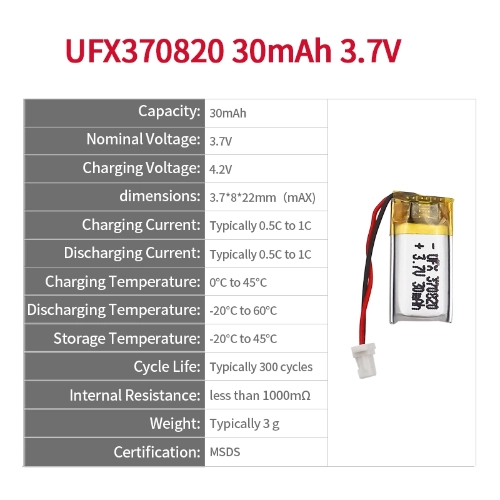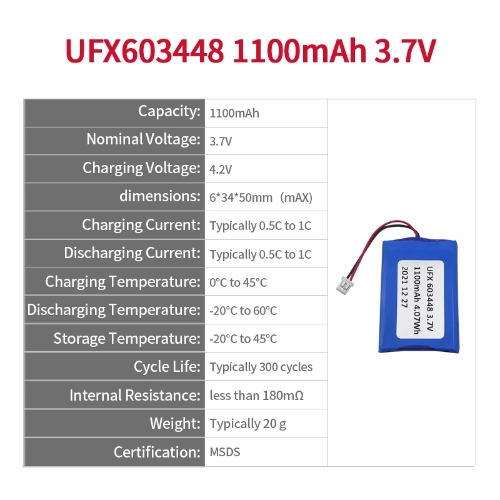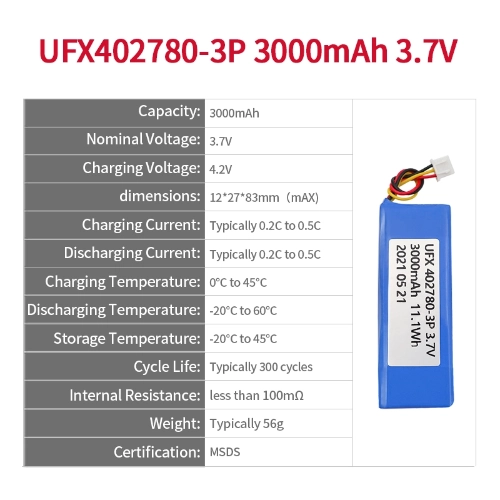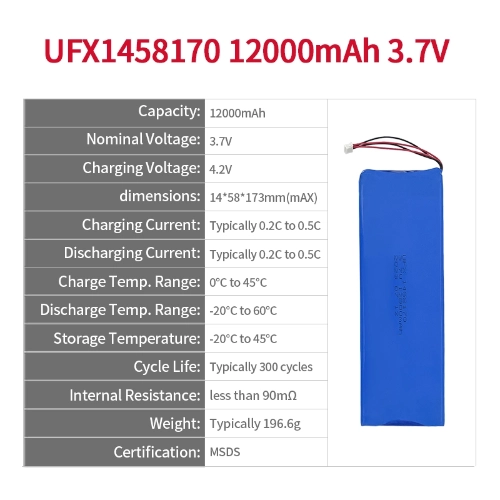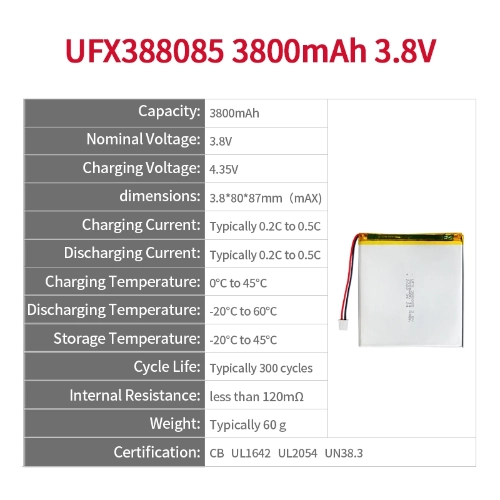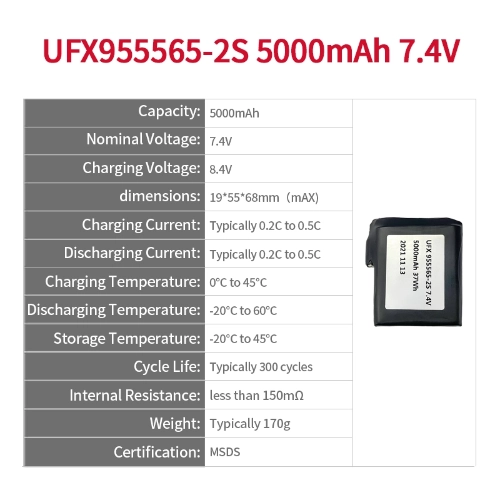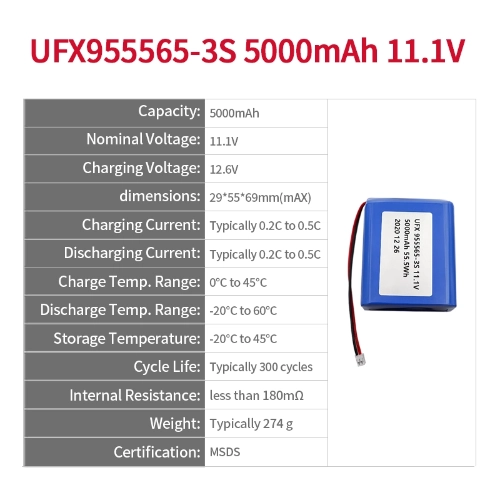Are you tired of your favorite control car losing power in the middle of those exciting races? Well, you need to understand the magic of RC LiPo batteries.
These mini powerhouses carry the answers to even more playtime and better performance, but delving into the world of RC batteries can be pretty intimidating. You need not worry because this all-inclusive guide is here to uncomplicate all things RC LiPo batteries and leave you with the ability to make informed decisions and squeeze all the fun out of your RC adventures.
So, let’s get this started.
Part 1. Why choose the Ufine RC LiPO battery? Top 7 picks
A good lithium polymer battery for the RC will ensure performance and longevity during test times for the remote control devices. One of the key features regarding the Ufine selection of RC Lipo batteries is comprehensive coverage.
From 30mAh to 12000mAh, our batteries are available in a range of capacities that would take care of varying power requirements and specifications of devices. On the other hand, Li-ion 3.7V batteries are available in different capacities to ensure they fit in low- and high-draining applications.
For higher voltage devices, Ufine can provide 3.8V, 7.4V, and even 11.1V, so they should work just fine for all those power-guzzling models of RC.
Ufine batteries endure long performance through careful design. The batteries keep over 80% of the capacity even after 500 cycles, which speaks for our durability and cost efficiency in the long term.
We also have built-in protections against overcharge, over-discharge, and short circuits, increasing safety and reliability.
Besides, the batteries can work in a wide temperature range, making them apt for rough use – from extremely cold to high temperatures.
In addition, Ufine is committed to adopting modern ecological standards with A-grade eco-friendly battery cells, which conserve energy and are friendly to the environment. That’s why we build our batteries to perform at a high level, meeting modern ecological standards.
Here are the top 7 we selected:
a. 3.7 V 30mAh Lithium Ion Battery 370820
b. 3.7 V 1100mAh Lithium ion Battery 603448
c. 3.7 V 3000mAh Lithium Ion Battery 402780-3P
d. 3.7 V 12000mAh Lithium Ion Battery 1458170
e. 3.8 V 3800mAh Lithium Ion Battery 388085
f. 7.4 V 5000mAh Lithium Ion Battery Pack 955565-2S
g. 11.1 V 5000mAh Lithium Ion Battery Pack 955565-3S
Part 2. What are LiPo batteries and how do they work?
Lithium Polymer batteries, shortened to LiPo, are the most used power source in remote control. How do they differ from the usual nickel-based batteries?
Now, let’s get to the basics to understand that. LiPo batteries depict a variety of secondary cell batteries that apply lithium-ion technology in recharging these batteries. The battery typically exhibits good energy density and low self-discharge. That means they make much power packed inside a small, light package, perfect for powering remote control cars.
But then, how do they work their magic? Unlike conventional batteries, LiPo cells use a polymer electrolyte; this permits flexible packaging with high energy densities. In a cell, lithium ions move from the negative electrode or anode to the positive electrode or cathode during discharge and vice versa during charging.
This characteristic chemistry makes LiPo batteries provide high discharge rates, therefore acting as the source for sudden power bursts required in fast acceleration and dramatized movements in RC cars. With their design, they are very light by nature, meaning that overall, their weight reduces the model’s weight, and the model has better handling ability and agility on the track.
Now that you know the basic concept of LiPo batteries for your RC car, let’s run through their advantages.
Part 3. The advantages of LiPo batteries for remote control cars
These RC LiPo batteries are essential for supplying power to your remote-controlled car in various ways.
Let’s look at the pros that these bring instead of the standard battery options.
- High Energy Density: LiPo batteries have the highest energy density as specified among other types of batteries. Therefore, it packs more energy into a smaller, lighter package, allowing extended run times and better track performance.
- Lightweight Design: With the LiPo batteries, the great advantage is the lightweight build of the batteries. This would reduce the vehicle’s overall weight, resulting in better handling, faster acceleration, and more maneuverability during tight turns and jumps.
- Burst Discharge Capability: This is the high-performing feature of a LiPo battery that makes it suitable for RC cars, which would require sudden surges of power for an instant rush or sharp moves. LiPo batteries give you that punch to beat the competition every time. Whether out on the pavement or cutting through the dirt, these are the perfect batteries.
- Self-Discharge: The rate of self-discharge in LiPo batteries is extremely low compared to other rechargeable batteries. This keeps the charge for an extended period while not in use. This way, your remote control car is always ready to hit the track when the race bug bites.
- Brushless Motor Compatibility: LiPo batteries, designed for brushless motors, are standard in high-performance remote-control cars. Their high discharge rates and the delivery of power gel suitably with the efficiency and speed of brushless motors, so the driving experience is exciting.
A LiPo battery will let your RC car unleash its potential, and soon, you will beat the tracks confidently.
Now, let’s see how to choose the correct Lipo battery for a remote control car.
Part 4. How to choose the right LiPo battery for remote control cars?
Choosing suitable RC LiPo batteries requires considering many factors.
Some of them are as follows:
- Know Your Power Requirement in Your Remote Control Car: Before we look into the battery specs, it would be good to understand your RC car’s power needs. Understand that the power needs of different models and configurations are different.
- Estimate Voltage and Capacity Requirements: Consider the voltage and capacity as the most critical parameters for matching the vehicle’s requirements. The higher the voltage, the greater the speed and power it can deliver, while capacity is when the battery sustains the performance.
- Respect the C-rating and Discharge Rate: The c-rating indicates the rate at which the battery can give up the stored energy, with higher C-ratings required for high-performance vehicles and demanding applications.
- Make Sure the Cell Count and Configuration Match that of your Car: Ensure that the battery configuration and cell count match the specifications of the RC car. Mis-matched configurations may result in damaged performance.
- Size and Weight: consider the physical dimensions and weight requirements in that the battery should fit in its place in the car’s battery compartment without disturbing the balance or handling. Ensure to take into account both size and weight when making your selection.
- Compatibility Check: Make sure the battery is compatible with the Electronic Speed Controller of your RC car to avoid conflicts of compatibility or electronic destruction.
- Budget: Keep in mind your budget. Performance is critical, but you should consider your budget as well. Put a higher priority on batteries that strike the best balance between performance, reliability, and value for the money.
By carefully considering these points and going for a battery that suits one’s respective needs, one can enjoy the maximum performance and fun one’s control car can provide.
Part 5. Conclusion
This is all you need to know about LiPo batteries for your remote control cars. With such insight, you can take your RC adventure to the next level.
Remember, choosing the correct RC LiPo battery is crucial for maximizing performance, extending playtime, and ensuring the longevity of your beloved remote-controlled car.
Related Tags:
More Articles

Where to Buy 3.7 V Lithium Ion Battery 850mAh Nearby?
Where to buy a 3.7 V lithium-ion battery 850mAh nearby? Learn specs, how to choose the right one, and where to buy it fast from nearby or direct from makers.
CR123A 3.0 V Lithium Battery vs 16340 Battery: Difference explained
CR123A and 16340 batteries look alike but differ in voltage, safety, and use. Learn the key differences to choose the right one for your device.
NCR18650B Battery Explained: Uses, Specs, Lifespan
Discover everything about the NCR18650B battery, including specs, types, lifespan, applications, and tips to spot fakes before you buy.
Where to Find the Right 18650 Battery Wholesale?
Discover how to choose a reliable 18650 battery wholesale supplier, compare prices, ensure safety, and avoid common buying mistakes.
18650 Battery Short Circuit: Risks and Safety Tips
Discover what happens during a 18650 battery short circuit, warning signs, and how to avoid fire, damage, and hazardous failures in your devices.
